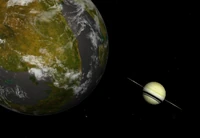| Cronus | |
|---|---|

| |
| Astrological characteristics | |
| Galaxy | Milky Way |
| System | Iota Horologii |
| Orbital characteristics | |
| Orbital period | 311.3 d |
| Eccentricity | 0.22 |
| Inclination | 97.2° |
| Physical characteristics | |
| Mass | 2.24 MJ |
| Radius | 73,350.7 km |
| Rotation period | 9.72 h |
| Gravity | 4.66 g |
| Albedo | 0.79 |
Cronus, scientifically classified as Iota Horologii b, is a jovian planet orbiting the star Iota Horologii.
Characteristics
Cronus orbits its sun in the inner habitable zone, meaning that it has some water in its atmosphere. Sulfur gas plays an important role in the planet's clouds, but is only a small part of it. Sulfuric clouds are found in the planets upper atmosphere, causing the planet to have a yellowish tint.
The planet has a ring system orbiting around the equator (similar to Saturn's rings), which is primarily due to the high amount of asteroid debris in the system. The rings keep on refreshing themselves after every collision with Cronus.
The planet has a complex magnetosphere in the same matter as Jupiter's, causing the inner moons to be radiated and inhabitable.
Moons of Cronus

Lenin and Cronus.
Similar to Jupiter and Saturn, Cronus has countless moons (most being small captured asteroids). However, there are six spherical moons in orbit around the planet. The inner most moon (Stalin) orbits within the ring system, making a huge gap in the rings. The close proximity has also caused the moon to most resemble Io, in that it is covered in active volcanism.
The two largest moons (Lenin and Trotsky) are active in the fact that they both have thick atmospheres. Trotsky (the largest) would most resemble Venus, with a thick, crushing atmosphere of carbon dioxide and sulfuric acid. Lenin (on the other hand) is much more habitable than any of the other moons. The surface is covered in oceans of rusty water (giving the moon a brownish tint), and ecology on the surface. Besides some differences, there is not much difference between Lenin and Earth.
The other three moons are virtually dead, lifeless worlds (similar to the Moon).
| Name | Radius (km) | Mass (Earth) | Orbital radius (km) | Orbital period (days) |
|---|---|---|---|---|
| Stalin | 1,000 | c/s | 250,000 | 0.92 |
| Bukharin | 900 | c/s | 650,000 | 11.11 |
| Kalinin | 1,769 | c/s | 914,364 | 14.00 |
| Lenin | 3,279 | c/s | 1,700,000 | 25.0 |
| Trotsky | 3,763 | c/s | 3,000,000 | 80.0 |
| Sverdlov | 1,500 | c/s | 7,000,000 | 100.0 |
See also
- Iota Horologii b (Wikipedia)
External links
- Iota Horologii. Sol Station.
- Iota Horologii b. Extrasolar Visions.